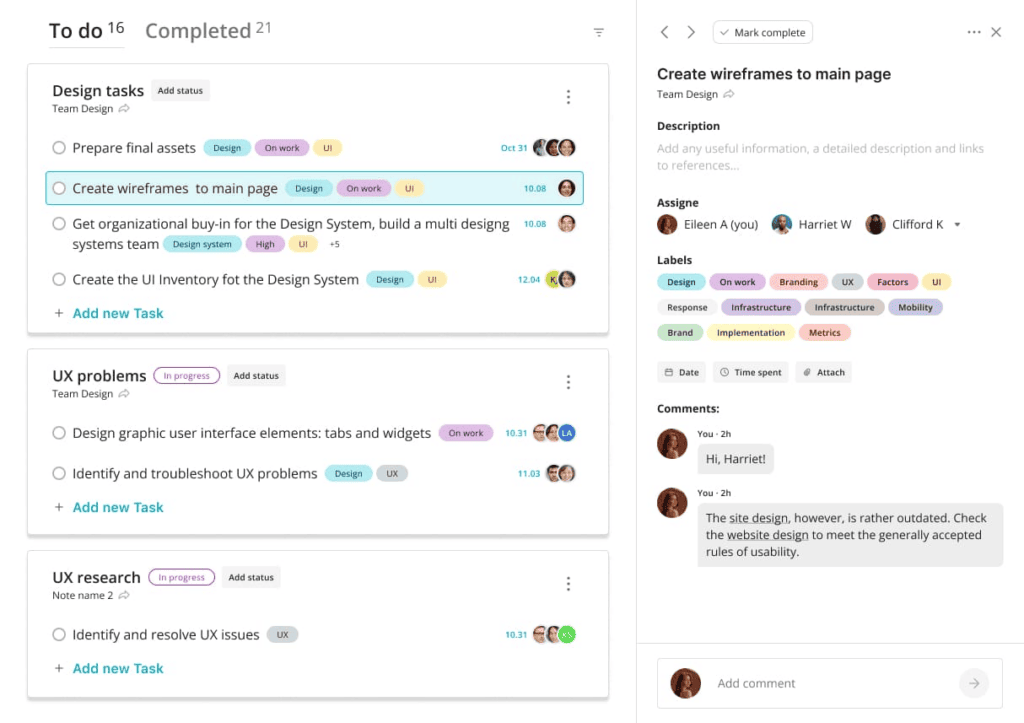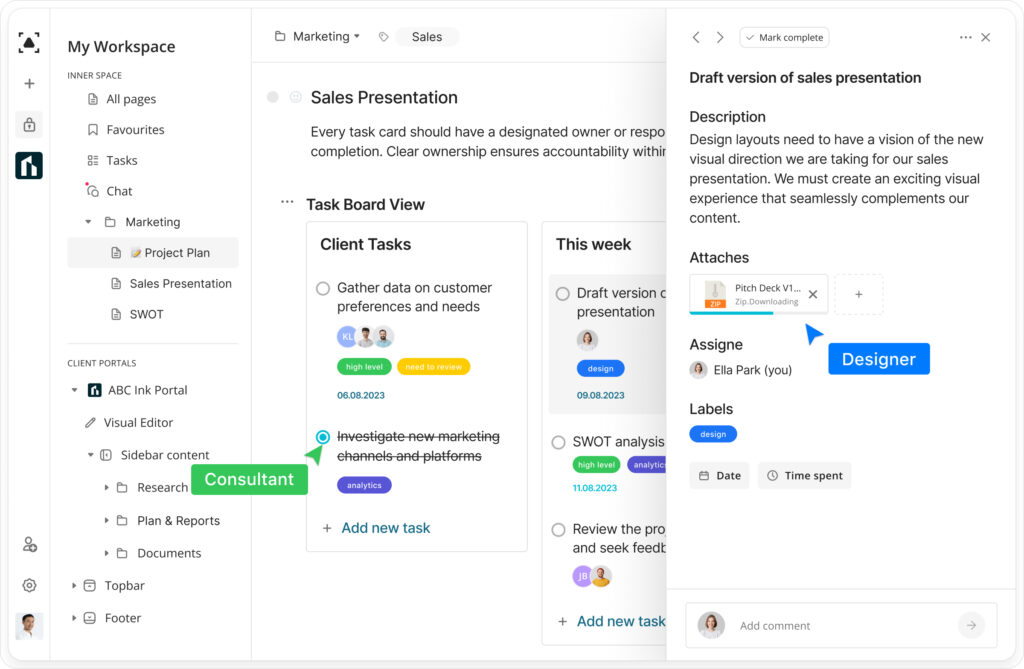
Onboarding vs. Implementation: Do You Need Both?
- 9 Min read
Have you ever thought, “This could have been an email” after an extended team or client meeting? Do you want to avoid synchronizing schedules with international clients or facing difficulties with your current client communication strategies? It may be time to consider changes. Adapting to asynchronous communication can be a significant shift, particularly for improving client interactions.
Asynchronous communication has become irreplaceable in a world where business work hours are no longer confined to 9-to-5, and work environments span the globe. Whether you are a service business owner leading a remote team or a solopreneur working with international clients, asynchronous communication is the key to maximizing efficiency and flexibility in your operations. Learning the principles and benefits of async methods is also necessary for managers, digital professionals, and everyone working in a team.
Service businesses have a window of approximately two years to adopt asynchronous communication strategies or risk falling behind. And the sooner you do it, the better. Read further to learn how your business and clients will benefit from asynchronous communication.
In this article:
Let’s start with the definition of asynchronous communication. Asynchronous communication is an exchange of information that doesn’t require immediate response. This form of communication is especially beneficial in a globalized market where clients and teams span multiple time zones, ensuring that communication doesn’t depend on everyone being available simultaneously.
Adopt asynchronous communication using client portals
Asynchronous communication doesn’t mean that parties are given the right to ignore or ghost each other. This method of communication means prioritizing matters and optimizing workflow with no harm to productivity and collaboration. Asynchronous communication can make client onboarding, sharing feedback, and other daily interactions much smoother when used effectively.
The main difference between asynchronous and synchronous communication types is the level of flexibility each provides. Synchronous communication happens in real-time, while asynchronous communication allows participants to respond at their convenience. Different communication styles can cater to a variety of situations in the workspace.

Common examples of synchronous communication include:
Participants are engaged in the exchange simultaneously, as all communication happens “right here, right now“.
This type of communication is often preferred for discussing urgent matters, brainstorming sessions, or when immediate feedback is required. Synchronous communication can help when you need to solve issues quickly.

On the other hand, examples of asynchronous communication include:
While asynchronous communication is slower, it offers many benefits, especially for distributed teams and clients. The asynchronous method of communication is ideal for non-urgent matters, allows time for thoughtful responses during work hours, and is flexible for team members and clients across different time zones.
Both synchronous and asynchronous communication methods have their place in business and personal interactions. The key is to choose the proper method and tool based on the nature of the communication, the urgency of the response needed, and the participants’ convenience.
Now that you know the difference between synchronous and asynchronous, you might wonder which communication type is needed for your business. While the answer is both, asynchronous communication is vital for project success and client satisfaction. We recommend using synchronous communication only in particular cases when needed and prioritizing forms of asynchronous communication.
Historically, client communication was synchronous, relying on real-time interactions such as phone calls or face-to-face meetings. However, the last decade has seen a gradual but decisive shift. Clients now prefer the convenience and flexibility of asynchronous communication. They appreciate engaging with service providers on their own schedule without the pressure of immediate responses.
“Asynchronous communication gives my clients an opportunity to communicate at their own pace when they have time for it. They have jobs, kids, and responsibilities that they can not neglect. It is much easier for us to collaborate in FuseBase using chats and forms on client portals”
said Valery Berezhna, a professional coach.
A study by Zendesk revealed that 70% of customers expect a company to have a self-service portal or content available to them. Knowledge bases and client portals are forms of asynchronous communication that provide self-service and drive customer satisfaction. Moreover, they are easy to set up and personalize.
We conducted a survey in which 57% of business owners and managers claimed their clients prefer the option of asynchronous communication. In the next two years, this async preference is expected to intensify. Client communication requires flexibility, personalization, and attentiveness to detail.
Discover the best practices for utilizing client portals
Clients will increasingly favor businesses that offer asynchronous communication options, viewing them as more adaptable and client-centric.
Why the urgency? Asynchronous communication offers the flexibility of interactions at different times for each participant and is rapidly becoming the norm. This shift toward asynchronous communication is fueled by technological advancements that enable more efficient, flexible, and user-friendly communication methods.
Asynchronous communication can help expand your reach beyond local time zones and geographical boundaries. It means you can effectively communicate with clients and team members across the globe without the constraints of synchronizing schedules.
Whether sending a project update via email to a client in a different continent or receiving a “task completed” notification from a remote team member, asynchronous communication ensures that your business is always on, even when you are off.
Asynchronous communication empowers individuals to manage their time more effectively. It allows team members to work during their most productive hours and respond to communications at a time that suits them best. This flexibility can lead to higher-quality work, allowing individuals to think more deeply about their responses and contributions.
Moreover, it supports a healthier work-life balance, reducing the stress of needing to respond immediately and allowing for a more measured, thoughtful approach to work.
Asynchronous communication is inclusive, offering flexibility that can benefit team members with caregiving responsibilities, those living with disabilities, or those who work better during non-traditional hours.
This inclusivity enhances employee satisfaction and broadens the talent pool businesses can draw from. Asynchronous communication in the workplace is one of the keys to productive collaboration.
Implementing asynchronous communication tools in your business will streamline workflows and decision-making processes. Interactive tools like project management software provide a transparent view of progress and challenges, allowing for more strategic planning and decision-making.
Instead of waiting for the next meeting to discuss progress, remote workers can update their tasks in real-time, enabling quicker responses to challenges and opportunities. Moreover, asynchronous communication means documented communication, so none of the matters discussed get lost or forgotten.
Asynchronous communication also supports a culture of continuous learning and improvement. Team members can share resources, feedback, and insights at their convenience, contributing to a collective knowledge base that parties can access anytime.
This ongoing exchange of information fosters a learning environment where skills and knowledge are constantly developed and shared.
Early adopters of asynchronous communication are already reaping benefits. These include increased efficiency, better time management, and the ability to serve a broader client base across different time zones.
Companies integrating asynchronous communication apps and practices into their operations are now positioning themselves at the forefront of a significant shift in workplace communication and client interaction. Here are five benefits of asynchronous communication that early adopters already experience:
1) Boosted client satisfaction
Early adopters have the unique opportunity to cater to the growing preference for asynchronous communication among clients. According to a study by Forrester Consulting, 76% of respondents reported that asynchronous communication enhances overall client engagement.
Businesses can significantly enhance client satisfaction by offering flexible and convenient communication options. Clients appreciate the ability to interact on their terms and timelines, which can lead to stronger, longer-lasting business relationships.
2) Maximized operational efficiency
A Harvard Business Review shared that 65% of senior managers surveyed said meetings keep them from completing their own work, and 71% said meetings are inefficient and come at the expense of deep thinking. Asynchronous communication tools streamline many aspects of business operations. They reduce the need for lengthy meetings, minimize disruptions caused by unscheduled calls or discussions, and allow more focused and productive work periods.
This efficiency cuts operational costs and speeds up project timelines, allowing businesses to take on more work and grow faster.
3) Better chances at attracting and retaining talent
In the current job market, employees highly value flexibility and work-life balance. According to the HBR, 59% say flexibility is more important than salary or other benefits. Businesses that offer asynchronous communication options are more attractive to top talent who seek a more flexible and autonomous work environment.
4) Strengthened business model
According to Inc., between 36 and 56 million meetings are held in the US daily, and the productivity loss caused by ineffective meetings costs businesses anywhere from $70 to 283 billion yearly. Asynchronous communication fosters a resilient business model adaptable to various scenarios, such as remote work, global teams, and unexpected disruptions.
Businesses that have already integrated these practices are better equipped to handle challenges like global crises or natural disasters that can disrupt traditional work patterns.
5) Staying ahead of the curve
A study by Sony shows that 42% of employees surveyed believe asynchronous work is the future. Early adoption of asynchronous communication puts businesses ahead of the curve, not just in terms of technology but also in adopting a forward-thinking approach to work.
It demonstrates a commitment to innovation and adaptability, which are increasingly important in a rapidly changing business world. Adopt asynchronous communication to create an image of a proactive, innovative brand.
Most importantly, adopting asynchronous methods leads to more thoughtful and well-considered communication, improving the quality of interactions and overall client collaboration processes.
Using AI in asynchronous communication with teams and clients can greatly enhance efficiency and clarity. AI-driven language processing tools can analyze the content of messages for sentiment, urgency, and relevance, helping to prioritize communications.
For global teams, AI-powered translation services can be invaluable in breaking down language barriers, allowing for seamless communication across different languages. This ensures that all team members, regardless of their native language, can fully participate and understand the information being shared.

Furthermore, AI can facilitate the organization and archiving of communication threads, making it easier to retrieve past conversations and relevant documents. This enhances the team’s ability to track the progress of discussions, decisions made, and action items, which is particularly useful in long-term projects.
Businesses that embrace this shift early are already gaining a competitive edge, and are seen as forward-thinking and responsive to client needs. Do you want to start implementing these changes now? Let’s find out how to make asynchronous communication work.
Asynchronous communication isn’t a modern convenience; it’s a pivotal adaptation, and implementing asynchronous communication strategies requires a thoughtful approach. Here is an essential roadmap you can follow to adopt asynchronous communication into your workflow:
Step 1: Assess current communication methods
Evaluate how your team communicates internally and with clients and which tools the team uses. Identify which interactions are synchronous and which could be moved to asynchronous. Pick a communication channel for each type of matter.
Step 2: Select the right tools

Explore various asynchronous communication apps available in the market. Consider factors like user interface, security, compatibility with existing systems, and scalability. The list could include email platforms (GMail), messaging apps (Slack channel), project management tools, and collaborative platforms (FuseBase).
Step 3: Teach your team and clients
Ensure your team and clients are comfortable with the new tools and understand the importance of asynchronous communication to work better. Develop guides, FAQs, and video tutorials to help team members learn independently and improve client onboarding.
Step 4: Set clear guidelines
Asynchronous communication requires everyone to follow the rules to ensure everyone’s comfort. Establish guidelines for response times, communication etiquette, and managing client expectations in an asynchronous environment.
Create protocols for different types of communication and think of strategies for dealing with time zone differences, such as setting overlapping hours for real-time communication or using time zone scheduling tools.
Step 5: Ask for feedback, review, adapt
Use surveys or feedback forms (async methods) to collect detailed insights on user experience and satisfaction using the new communication methods. Continuously review the effectiveness of your asynchronous communication methods and be willing to adapt as necessary.
Follow this roadmap to implement asynchronous communication strategies in your organization effectively. If you want a more detailed guide, read our e-book.
Set up client portals to streamline collaboration and communication with clients
Optimized team communication and well-thought-out client interactions are keys to a project’s success, and asynchronous communication tools are essential for efficient team and client collaboration. By utilizing the best asynchronous communication apps, remote teams can stay connected and productive regardless of time zones and geographical locations.
Whether email, project management platforms, or messaging apps, the best asynchronous communication apps empower teams to work smarter, not harder. These tools enable team members to communicate important updates and information at their own pace and provide a platform for sharing ideas, feedback, and insights.

It supports 2000+ integrations and comes with Nimbus Capture, a tool for capturing and sharing screenshots and screen recordings. It helps create tutorials, demonstrate flows, provide feedback, and report issues.
Revolutionize client interactions with FuseBase client portals
By embracing these tools and adopting asynchronous communication, you can foster a more inclusive and flexible work environment where every member can contribute and stay informed. As a result, teams can achieve higher levels of productivity, creativity, and innovation.
In today’s digital era, asynchronous is rapidly becoming the norm. So, are you ready to streamline communication and improve client experiences? Engage in asynchronous communication for more flexible and accommodating client interactions, and respect their time and preferences while maintaining consistent and effective communication. Let’s lead the way for a more connected, efficient, and productive future!
Lead with confidence – claim your free eBook about client portals
Found it useful? Share the article with your community
Get weekly tips and insights on how to grow your business